Numerical and Experimental Analysis of the Rotational Stiffness of a Timber Semi-Rigid Dowel-Type Connection
Abstract
:1. Introduction
2. Materials and Methods
2.1. Description of Structure and Geometry
2.2. Description of the Testing Machine
2.3. Position of Gauge Sensors
2.4. Determination of the Rotational Stiffness
2.5. Description of the Loading Procedure of Quasi-Static Tests
- The first value for loading was calculated as 60% of the ultimate limit state value of load-carrying capacity. This load represents a common design situation of most load-carrying structures.
- The second value for loading was calculated as 80% of the ultimate limit state value of load-carrying capacity. This load is also a common design situation of some load-carrying structures.
- The third value for loading was calculated as 100% of the ultimate limit state value of load-carrying capacity. This load represents the maximum load of load-carrying structures in practice.
- Calculation of the maximum force Fed for the tested connection (i.e., 100% ULS);
- Loading of the specimen to 60% Fed, then holding for 30 s;
- Unloading to 10% Fed, then holding for 30 s;
- Repeating steps 2 and 3 four times, until a total of 5 load cycles is done.
2.6. Experimental Testing
2.7. Numerical Modeling
3. Results
3.1. Results of Experimental Testing
3.1.1. Experiment A, Bolts and Dowels
3.1.2. Experiment B, Fully Threaded Screws
3.2. Results of the Numerical Modeling
3.2.1. Experiment A, Bolts and Dowels
3.2.2. Experiment B, Fully Threaded Screws
4. Discussion
5. Conclusions
Author Contributions
Funding
Institutional Review Board Statement
Informed Consent Statement
Data Availability Statement
Acknowledgments
Conflicts of Interest
References
- Granholm, H. Om Sammansatta Balkar och Pelare med Särskild Hänsyn Till Spikade Träkonstruktionr. Handlingar 88; Chalmers Tekniska Högskola: Sweden, Gothenburg, 1949. [Google Scholar]
- Granholm, H. Der Einsturz des Bogengerüstes der Sandöbrücke; Verlag der Akademie der Wissenschaften und der Literatur: Mainz, Germany, 1963. [Google Scholar]
- Ehlbeck, J. Load-carrying capacity and deformation characteristics of nailed joints. In Proceedings of the CIB-W18, Paper 12-7-1, Bordeaux, France, 29 October 1979. [Google Scholar]
- Dubas, P.; Gehri, E.; Steurer, T. Einführung in die Norm SIA 164 (1981)–Holzbau; Publication No. 81-1; Baustatik und Stahlbau; ETH: Zürich, Switzerland, 1981. [Google Scholar]
- Lokaj, A.; Dobes, P.; Sucharda, O. Effects of Loaded End Distance and Moisture Content on the Behavior of Bolted Connections in Squared and Round Timber Subjected to Tension Parallel to the Grain. Materials 2020, 13, 5525. [Google Scholar] [CrossRef] [PubMed]
- Ehlbeck, J.; Werner, H. Untersuchungen über die Tragfähigkeit von Stabdübelverbindungen. Holz Roh Werkst. 1988, 46, 281–288. [Google Scholar] [CrossRef]
- Stoy, W. Holz-Nagelbau nach DIN 1052, 3. Ausgabe, 1940. 4. Ergänzte und Verbesserte Auflage; Schriftenreihe der Reichsarbeitsgemeinschaft Holz e. V; Reichsnährstandsverlag: Berlin, Germany, 1942. [Google Scholar]
- Ehlbeck, J.; Larsen, H.J. Eurocode 5 design of timber structures: Joints. In International Workshop on Wood Connectors; Barnes, M., Brauner, A., Galligan, W., Leichti, R., Soltis, L., Eds.; Forest Products Society: Madison, WI, USA, 1993. [Google Scholar]
- Jorissen, A. Double Shear Timber Connections with Dowel Type Fasteners. Ph.D. Thesis, Delft University of Technology, Delft, The Netherlands, 1998. [Google Scholar]
- EN 1995-1-1; Eurocode 5: Design of Timber Structures—Part 1-1: General—Common Rules and Rules for Buildings. Czech Standards Institute: Praha, Czech Republic, 2006.
- Kozelouh, B. Timber Structures According to Eurocode 5; STEP 1: Design and Construction Materials; Translated by Bohumil Kozelouh; KODR: Zlin, Czech Republic, 1998; ISBN 80-238-2620-4. (In Czech) [Google Scholar]
- Solarino, F.; Giresini, L.; Chang, W.-S.; Huang, H. Experimental Tests on a Dowel-Type Timber Connection and Validation of Numerical Models. Buildings 2017, 7, 116. [Google Scholar] [CrossRef]
- Vavrusova, K.; Mikolasek, D.; Lokaj, A.; Klajmonova, K.; Sucharda, O. Determination of carrying capacity of steel-timber joints with steel rods glued-in parallel to grain. Wood Res. 2016, 61, 733–740. [Google Scholar]
- Vassiliou, V.; Barboutis, I.; Kamperidou, V. Strength of Corner and Middle Joints of Upholstered Furniture Frames Constructed with Black Locust and Beech Wood. Wood Res. 2016, 61, 495–504. [Google Scholar]
- Cai, Y.; Young, B. Effects of end distance on thin sheet steel bolted connections. Eng. Struct. 2019, 196, 109331. [Google Scholar] [CrossRef]
- Požgaj, A.; Kürjatko, S. Wood properties of spruce from forests affected by pollution in Czechoslovakia. IAWA J. 1986, 7, 405–410. [Google Scholar] [CrossRef]
- Mirski, R.; Dziurka, D.; Chuda-Kowalska, M.; Wieruszewski, M.; Kawalerczyk, J.; Trociński, A. The Usefulness of Pine Timber (Pinus sylvestris L.) for the Production of Structural Elements. Part I: Evaluation of the Quality of the Pine Timber in the Bending Test. Materials 2019, 13, 3957. [Google Scholar] [CrossRef]
- Mirski, R.; Dziurka, D.; Chuda-Kowalska, M.; Kawalerczyk, J.; Kuliński, M.; Łabęda, K. The Usefulness of Pine Timber (Pinus sylvestris L.) for the Production of Structural Elements. Part II: Strength Properties of Glued Laminated Timber. Materials 2020, 13, 4029. [Google Scholar] [CrossRef]
- Nowak, T.; Karolak, A.; Sobótka, M.; Wyjadłowski, M. Assessment of the Condition of Wharf Timber Sheet Wall Material by Means of Selected Non-Destructive Methods. Materials 2019, 12, 1532. [Google Scholar] [CrossRef]
- Nowak, T.; Patalas, F.; Karolak, A. Estimating Mechanical Properties of Wood in Existing Structures—Selected Aspects. Materials 2021, 14, 1941. [Google Scholar] [CrossRef] [PubMed]
- Bragov, A.; Igumnov, L.; dell’Isola, F.; Konstantinov, A.; Lomunov, A.; Iuzhina, T. Dynamic Testing of Lime-Tree (Tilia Eu-ropoea) and Pine (Pinaceae) for Wood Model Identification. Materials 2020, 13, 5261. [Google Scholar] [CrossRef] [PubMed]
- Olaoye, K.; Aguda, L.; Ogunleye, B. Prediction of Mechanical Properties of Hardwood Species Using the Longitudinal Vib-ration Acoustic Method. For. Prod. J. 2021, 71, 391. [Google Scholar] [CrossRef]
- Martínez, R.D.; Balmori, J.-A.; Llana, D.F.; Bobadilla, I. Wood Density and Moisture Content Estimation by Drilling Chips Extraction Technique. Materials 2020, 13, 1699. [Google Scholar] [CrossRef]
- Dobes, P.; Lokaj, A.; Mikolasek, D. Load-Carrying Capacity of Double-Shear Bolted Connections with Slotted-in Steel Plates in Squared and Round Timber Based on the Experimental Testing, European Yield Model, and Linear Elastic Fracture Mechanics. Materials 2022, 15, 2720. [Google Scholar] [CrossRef]
- Braun, M.; Pełczyński, J.; Al Sabouni-Zawadzka, A.; Kromoser, B. Calibration and Validation of a Linear-Elastic Numerical Model for Timber Step Joints Based on the Results of Experimental Investigations. Materials 2022, 15, 1639. [Google Scholar] [CrossRef]
- Burawska-Kupniewska, I.; Beer, P. Near-Surface Mounted Reinforcement of Sawn Timber Beams-FEM Approach. Materials 2021, 14, 2780. [Google Scholar] [CrossRef] [PubMed]
- Zhou, S.; Li, Z.; Feng, S.; Zhu, H.; Kang, S. Effects of bolted connections on behaviour of timber frames under combined vertical and lateral loads. Constr. Build. Mater. 2021, 293, 123542. [Google Scholar] [CrossRef]
- Wang, M.; Song, X.; Gu, X.; Tang, J. Bolted glulam beam-column connections under different combinations of shear and bending. Eng. Struct. 2019, 181, 281–292. [Google Scholar] [CrossRef]
- Wang, X.T.; Zhu, E.C.; Niu, S.; Wang, H.J. Analysis and test of stiffness of bolted connections in timber structures. Constr. Build. Mater. 2021, 303, 124495. [Google Scholar] [CrossRef]
- Johanides, M.; Kubíncová, L.; Mikolášek, D.; Lokaj, A.; Sucharda, O.; Mynarčík, P. Analysis of Rotational Stiffness of the Timber Frame Connection. Sustainability 2021, 13, 156. [Google Scholar] [CrossRef]
- Johanides, M.; Mikolasek, D.; Lokaj, A.; Mynarcik, P.; Marcalikova, Z.; Sucharda, O. Rotational Stiffness and Carrying Capacity of Timber Frame Corners with Dowel Type Connections. Materials 2021, 14, 7429. [Google Scholar] [CrossRef] [PubMed]
- Johanides, M.; Lokaj, A.; Mikolasek, D.; Mynarcik, P.; Dobes, P.; Sucharda, O. Timber Semirigid Frame Connection with Improved Deformation Capacity and Ductility. Buildings 2022, 12, 583. [Google Scholar] [CrossRef]
- LaborTech. Available online: https://www.labortech.cz (accessed on 25 November 2021).
- Ahlborn. Available online: https://www.ahlborn.com (accessed on 25 November 2021).
- EN 26891; Timber Structures. Joints Made with Mechanical Fasteners. General Principles for the Determination of Strength and Deformation Characteristics. Czech Office for Standards. Metrology and Testing: Praha, Czech Republic, 1994.
- Ansys. Available online: https://www.ansys.com/ (accessed on 25 November 2021).
- Brožovský, Jiří a Alois Materna. Metoda Konečných Prvkůve Stavební Mechanice. 2012. Available online: https://docplayer.cz/414068-Metoda-konecnych-prvku-ve-stavebni-mechanice.html (accessed on 1 July 2022).
- David, M. Numerické Modelování Vybraných Spojů Dřevěných Konstrukcí; Disertační práce; Vysoká škola báňská–Technická univerzita: Ostrava, Czech Republic, 2012. [Google Scholar]
- Gunderson, R.A.; Goodman, J.R.; Bodig, J. Plate Tests for Determination of Elastic Parameters of Wood. Wood Sci. 1973, 5, 241–248. [Google Scholar]
- Larsen, H.J.; Reestrup, V. Tests on screws in wood. Bygn. Medd. 1969, 1, 3–36. [Google Scholar]

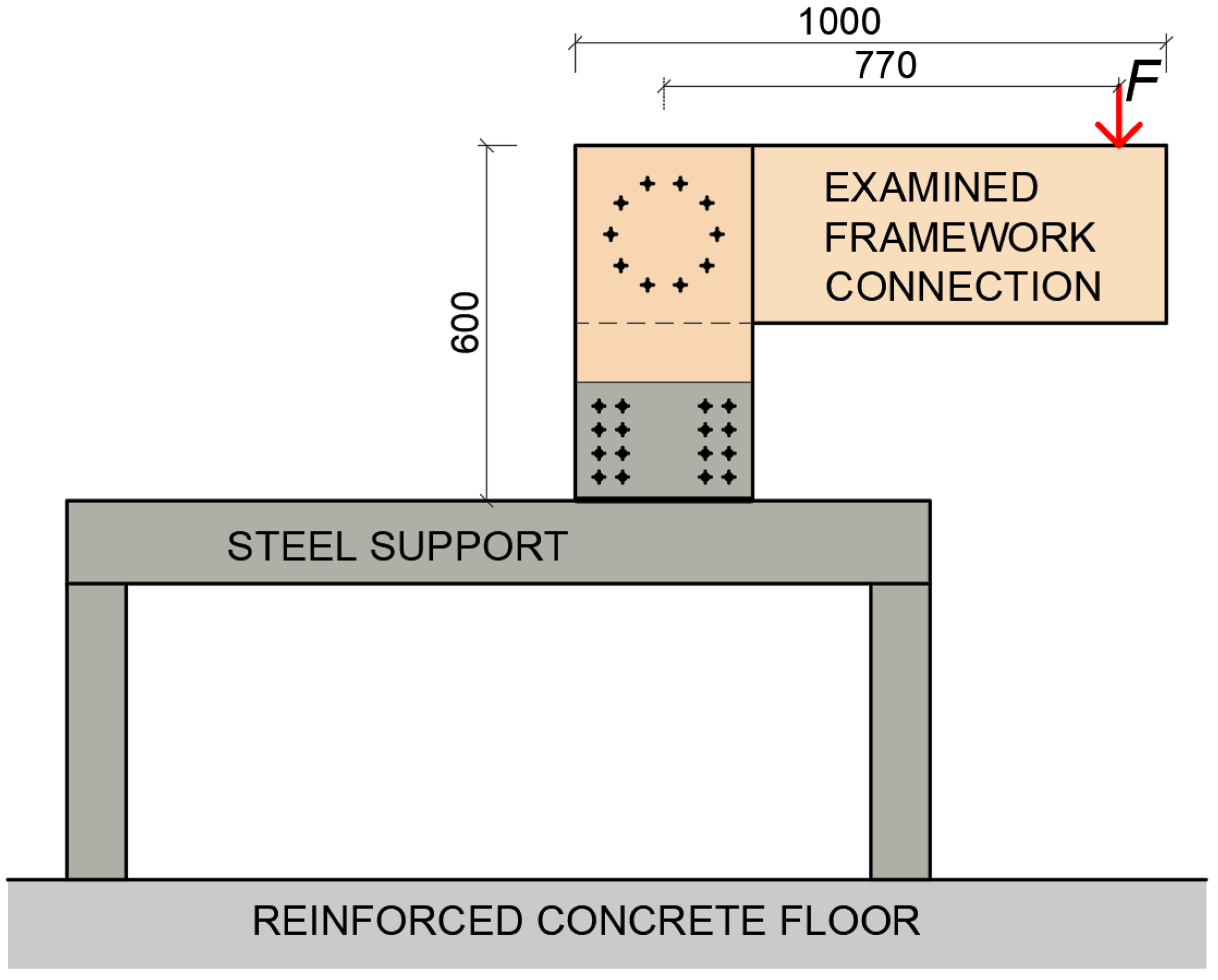

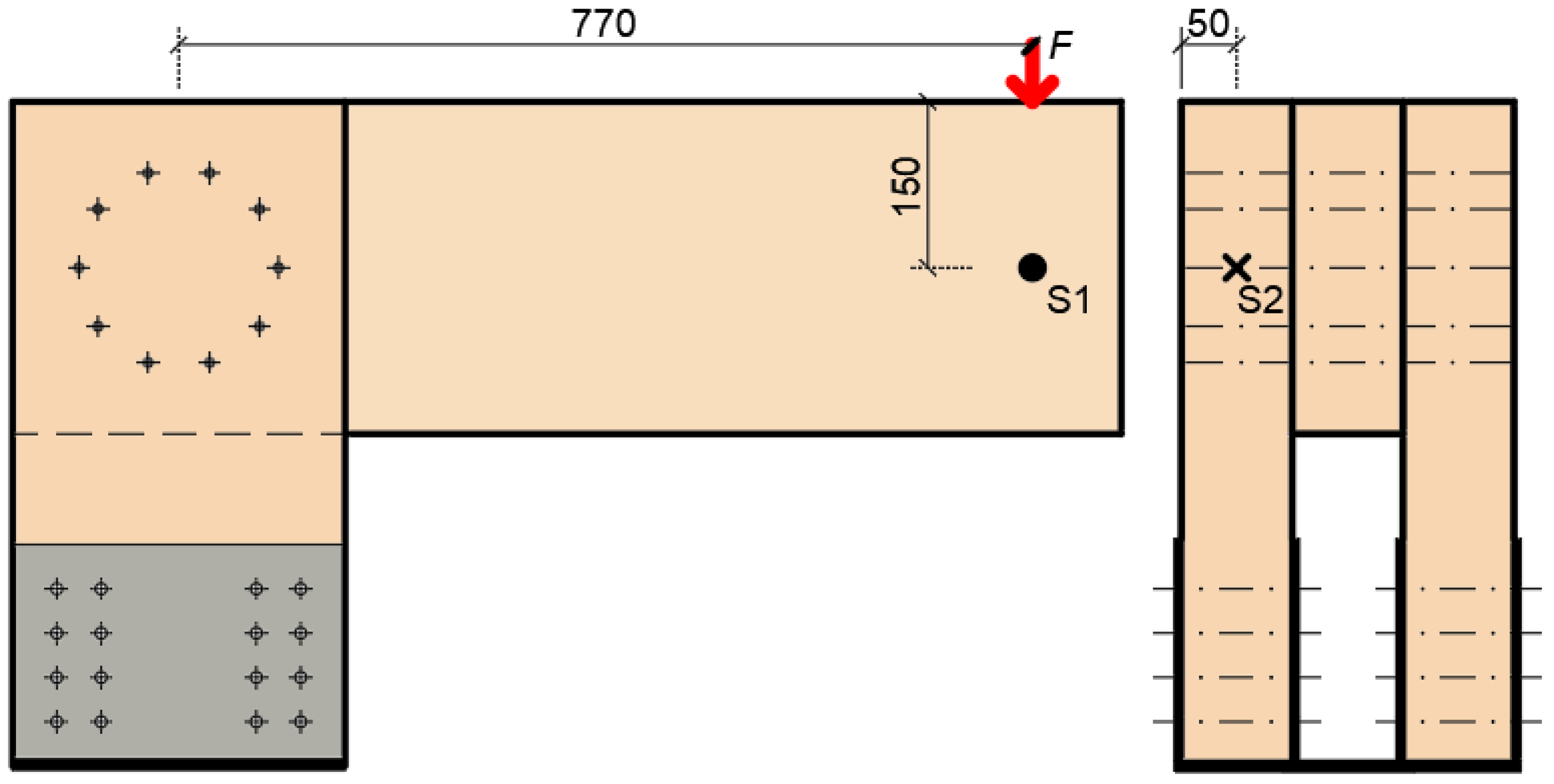
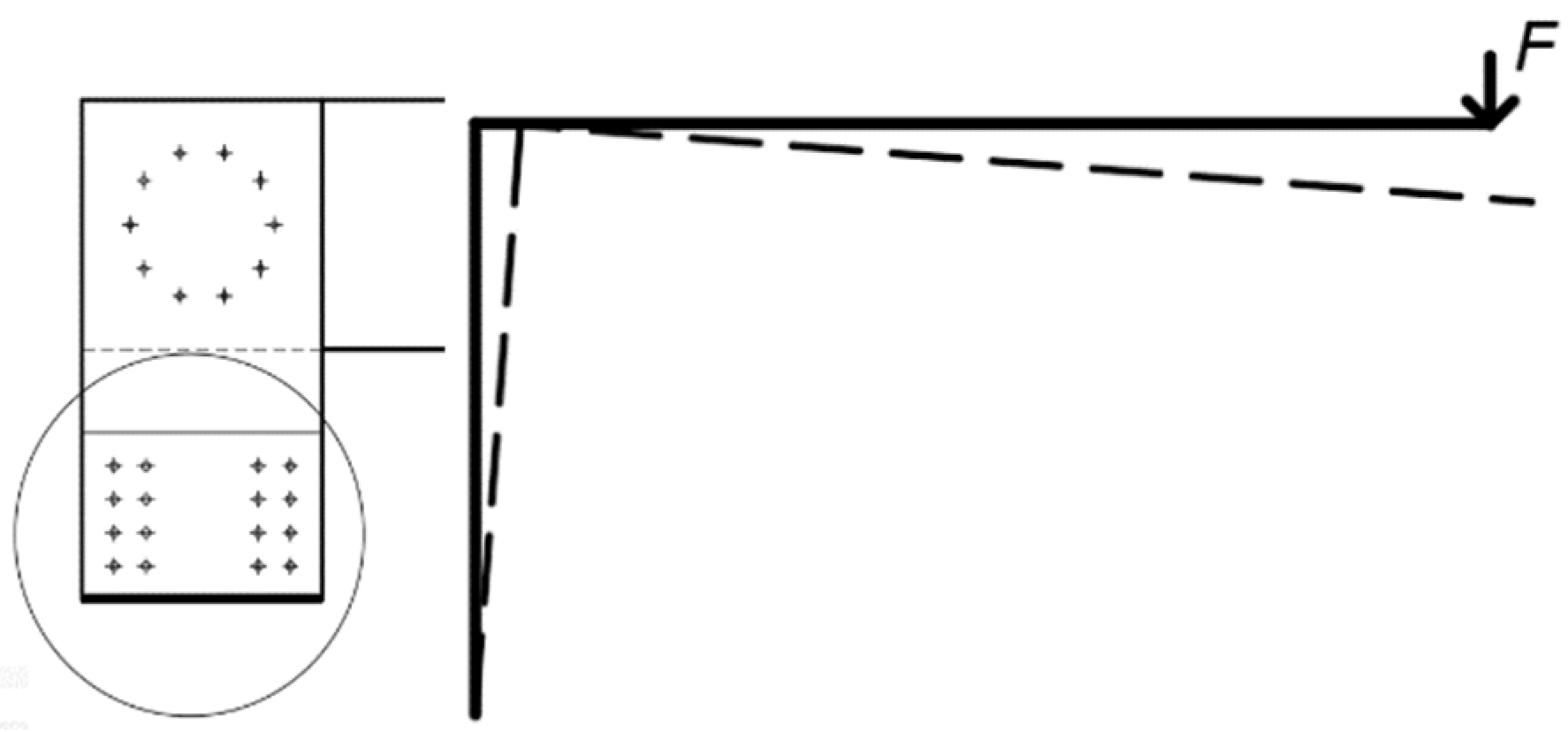
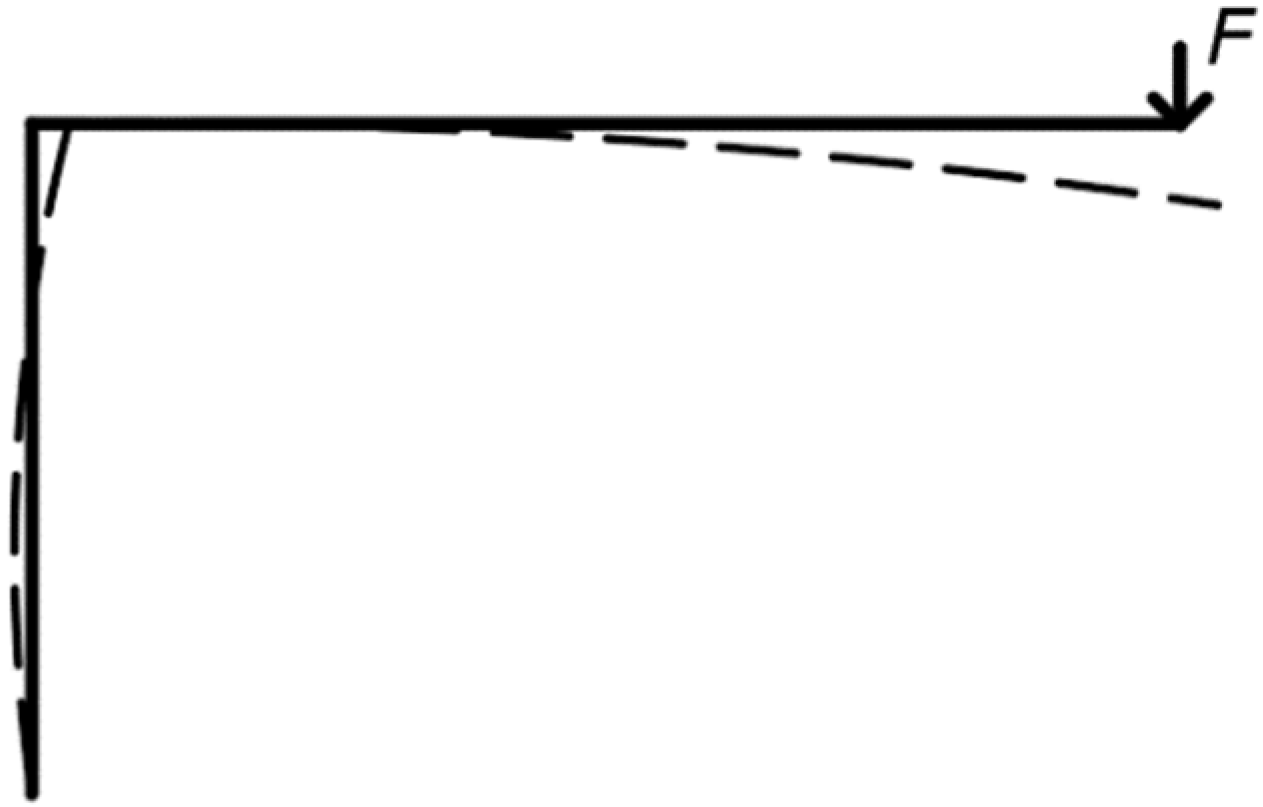

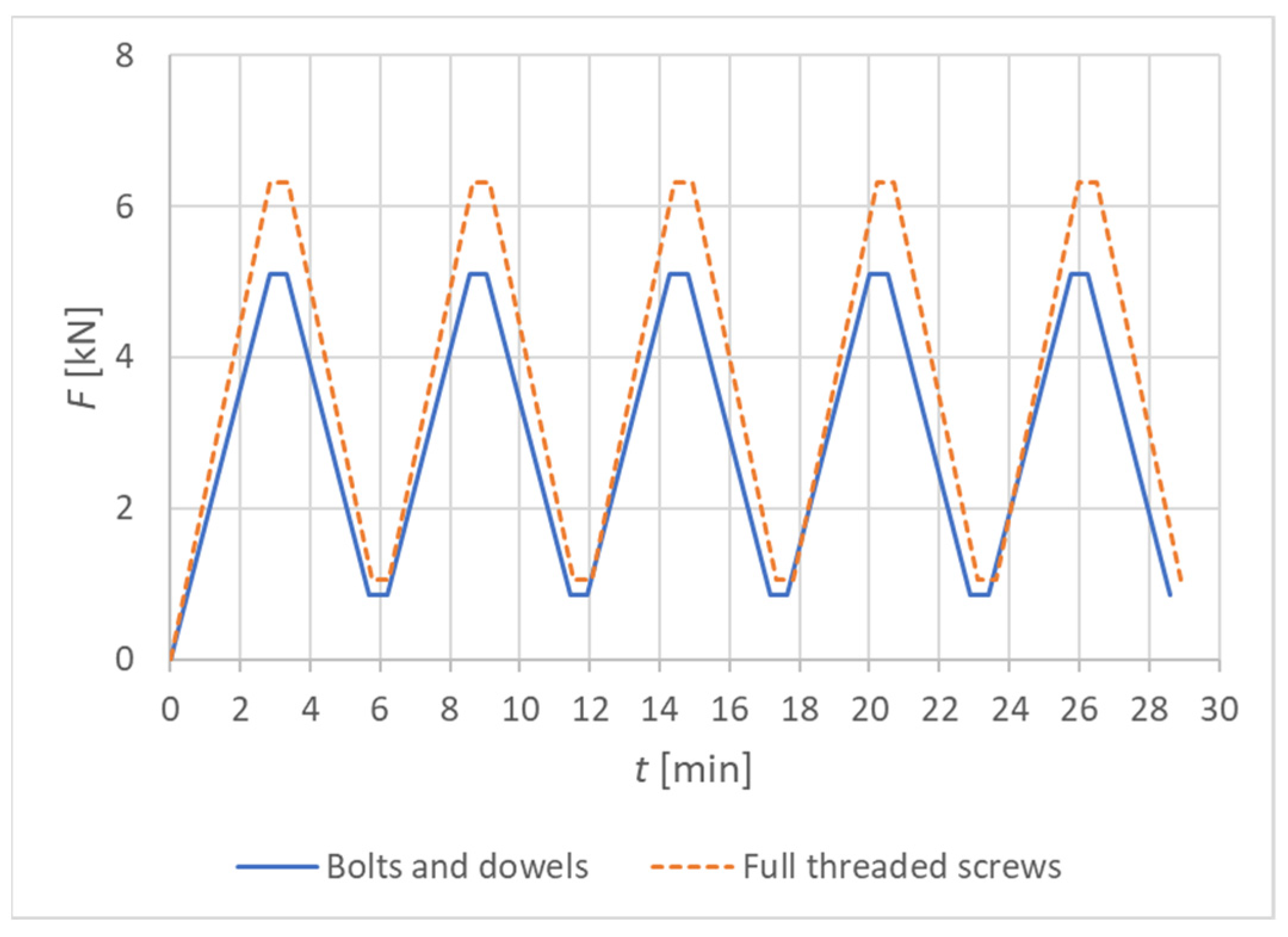
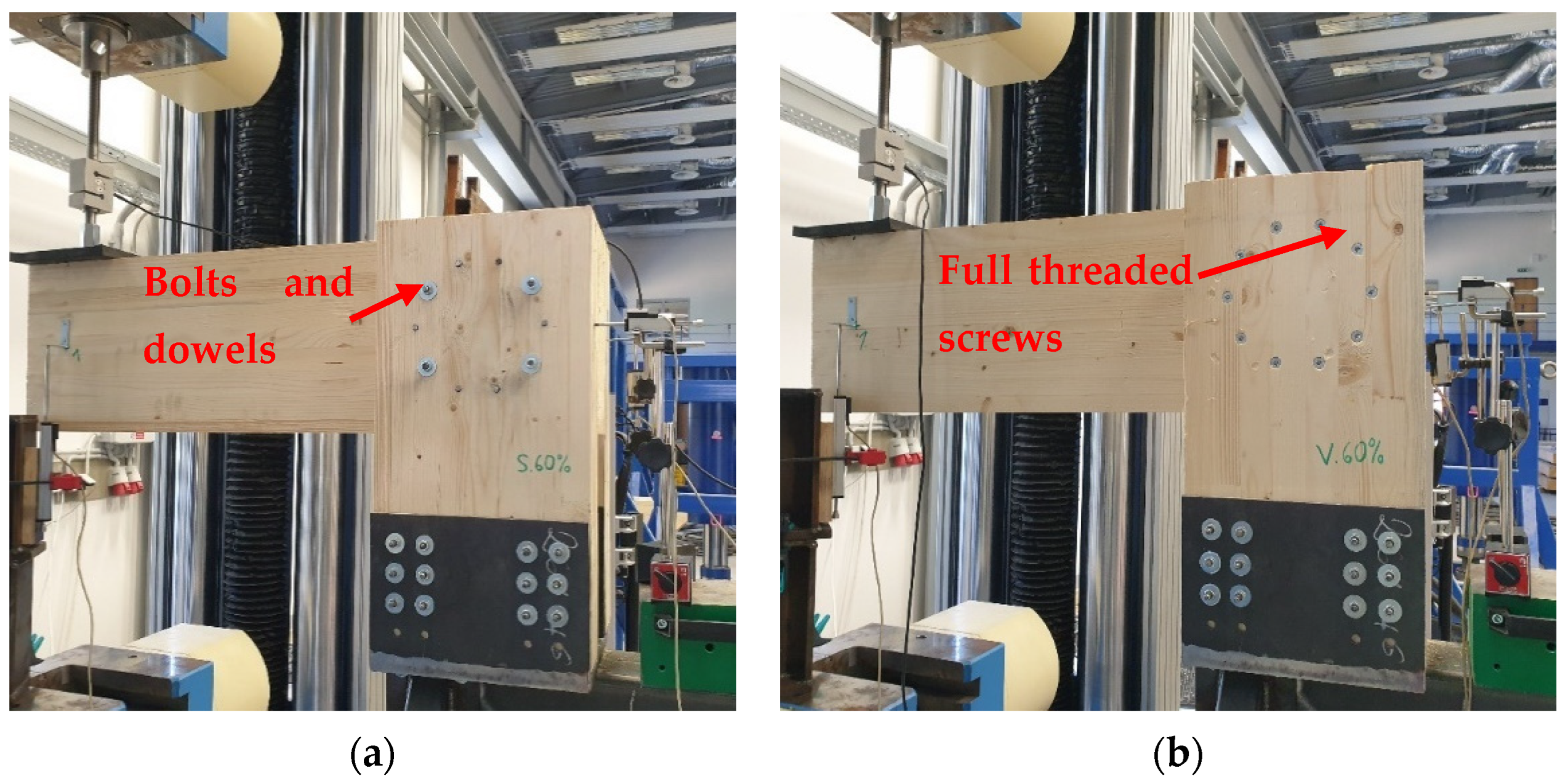
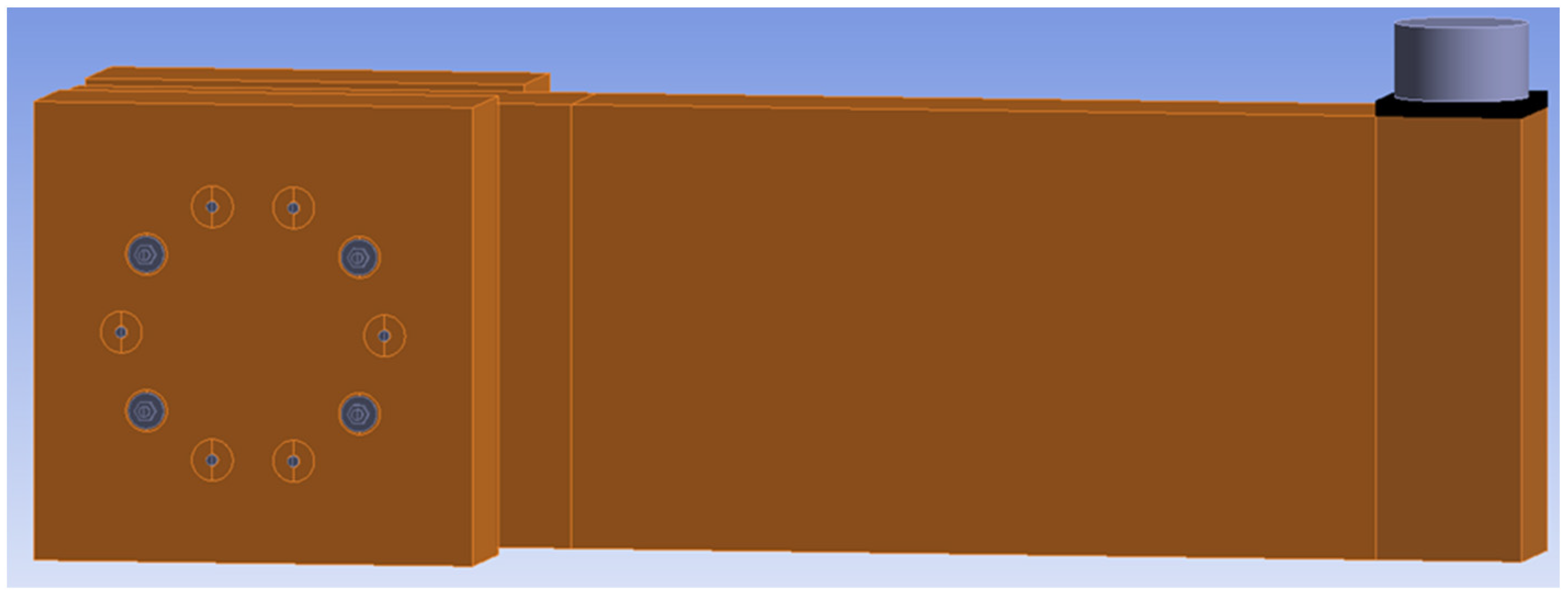


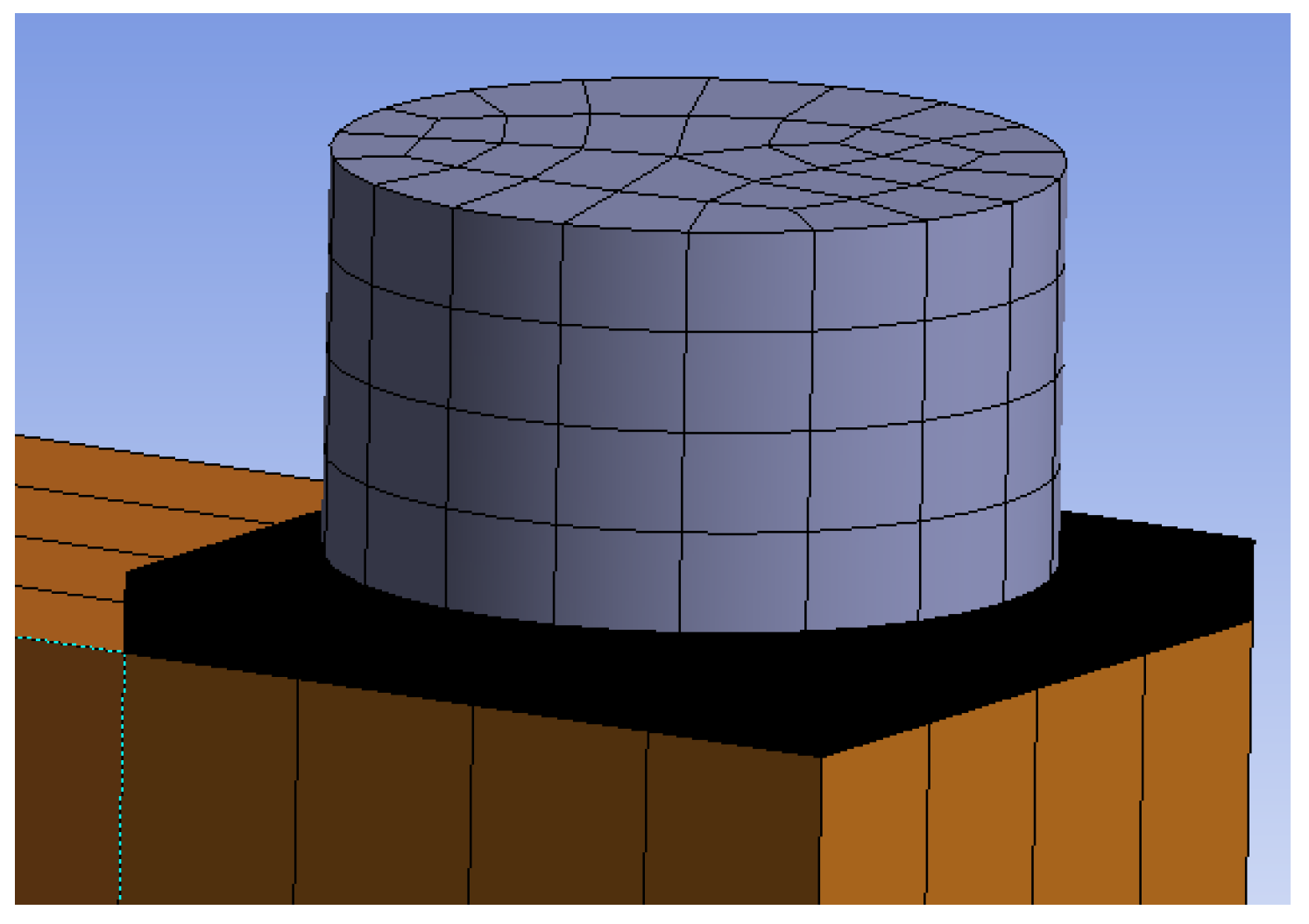
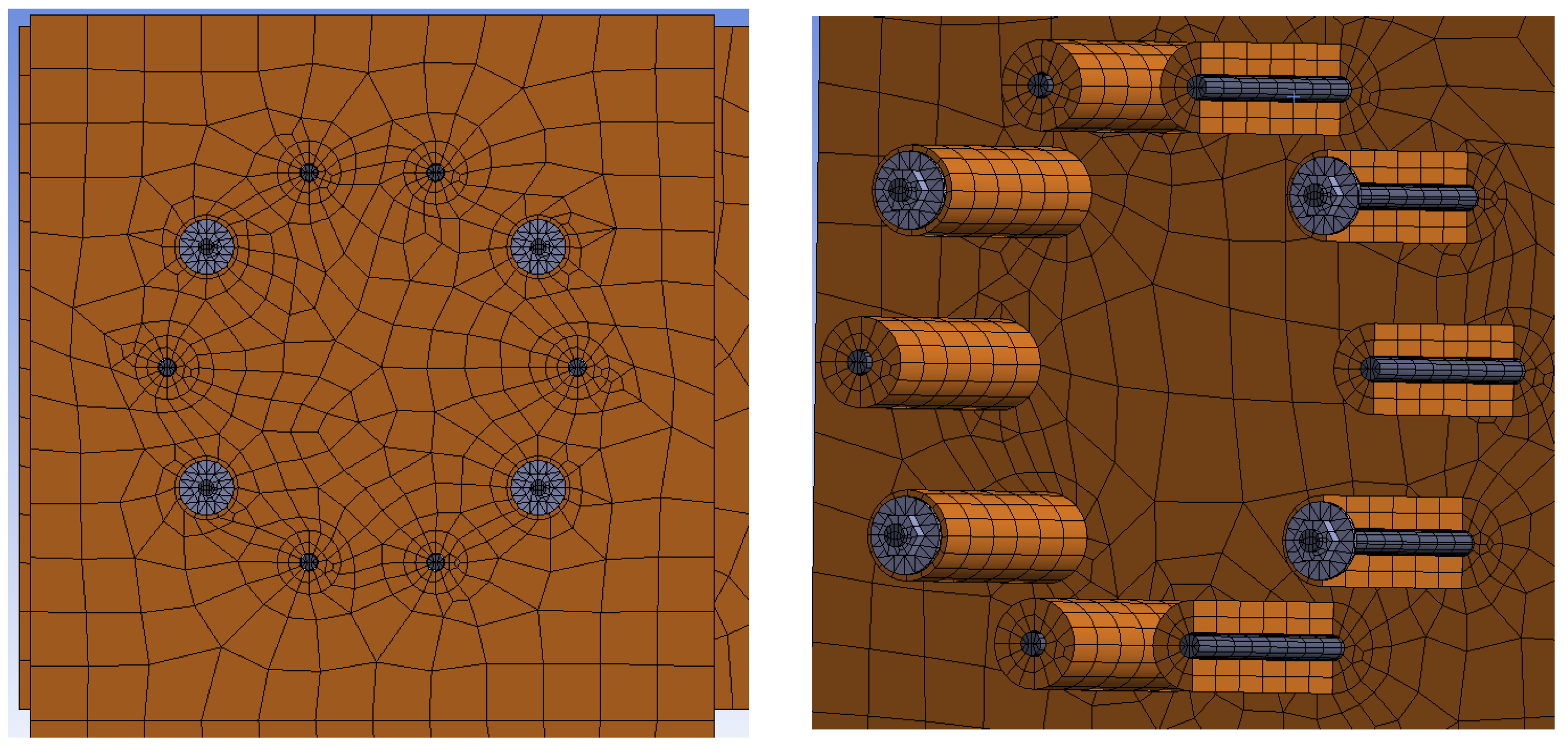
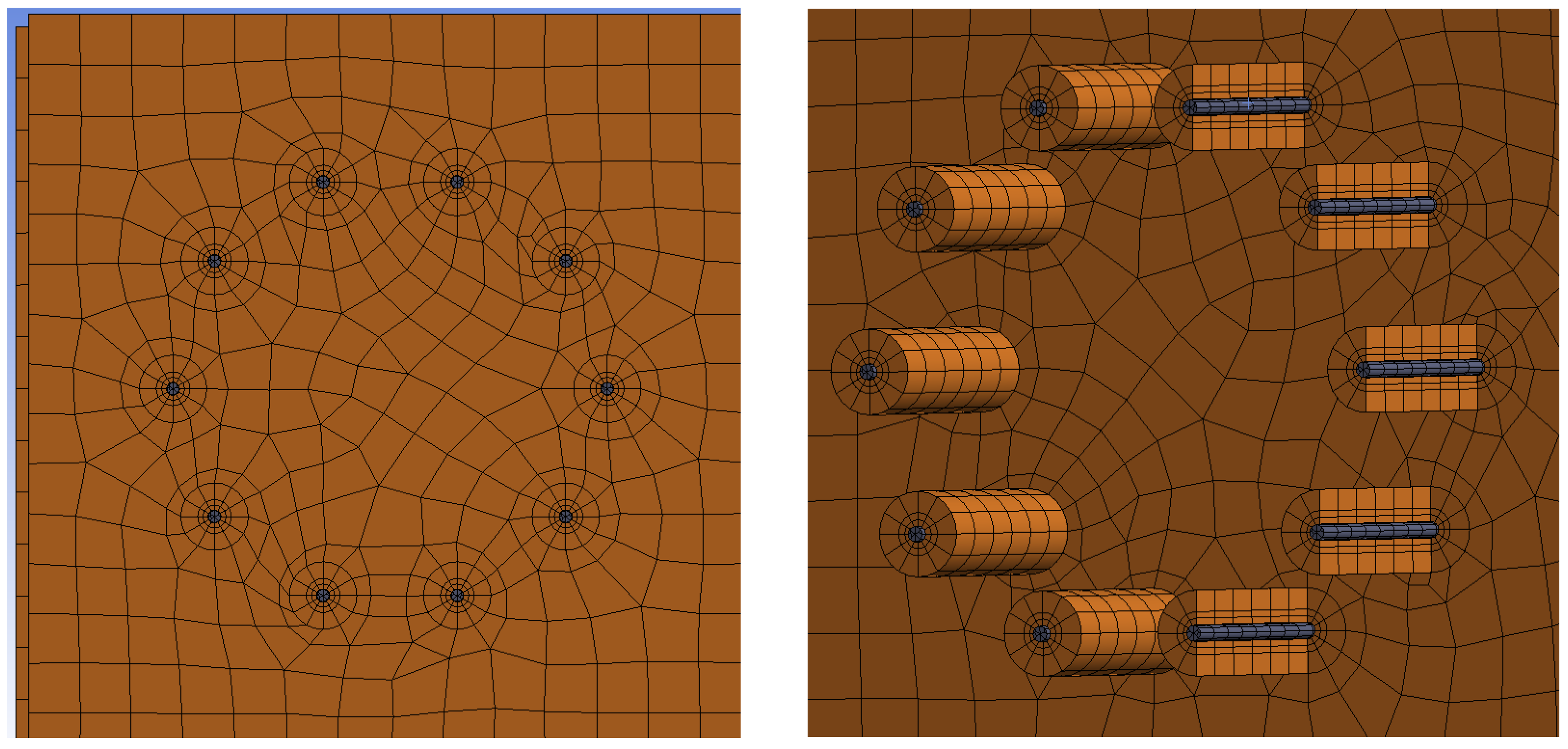

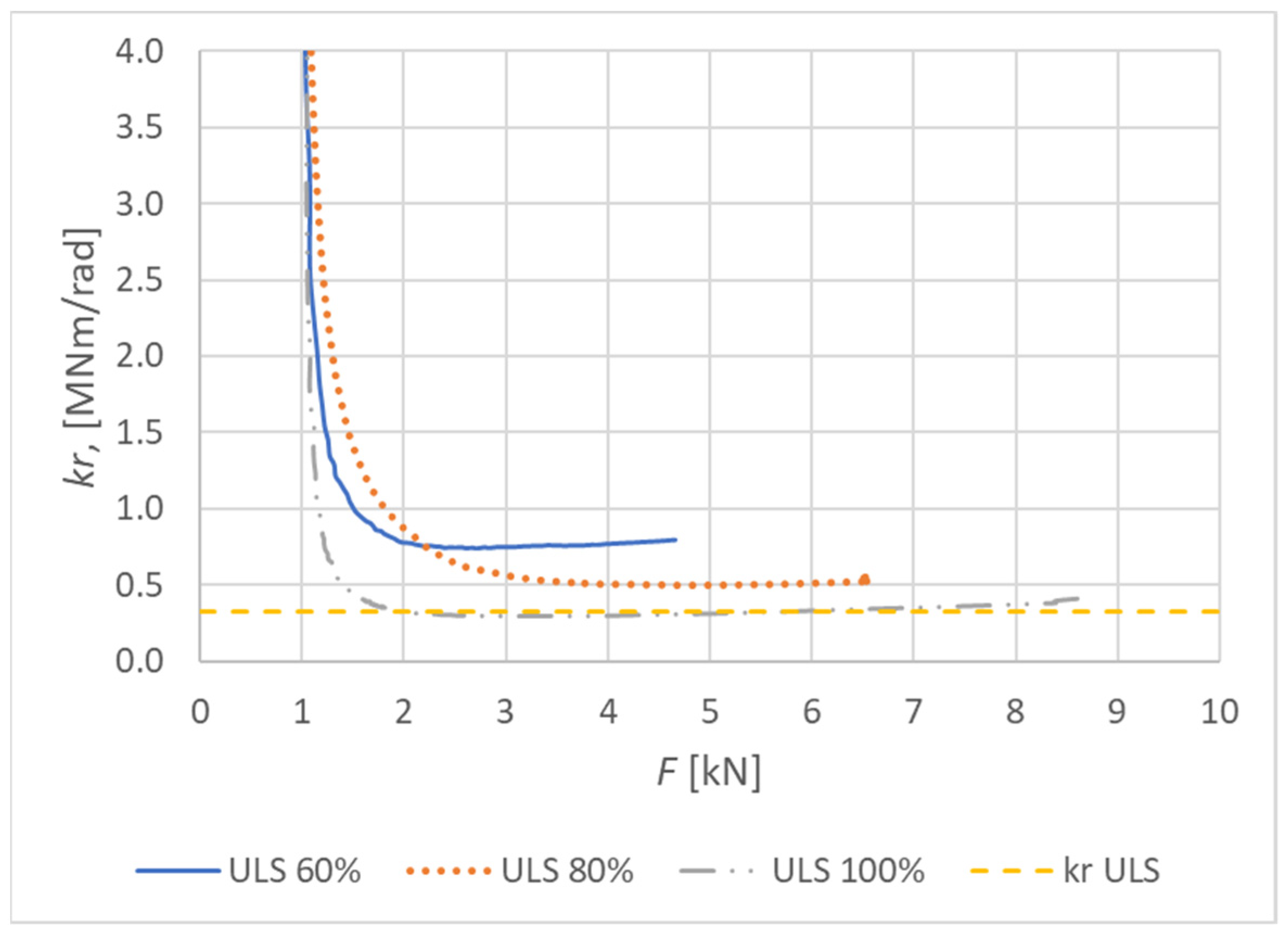
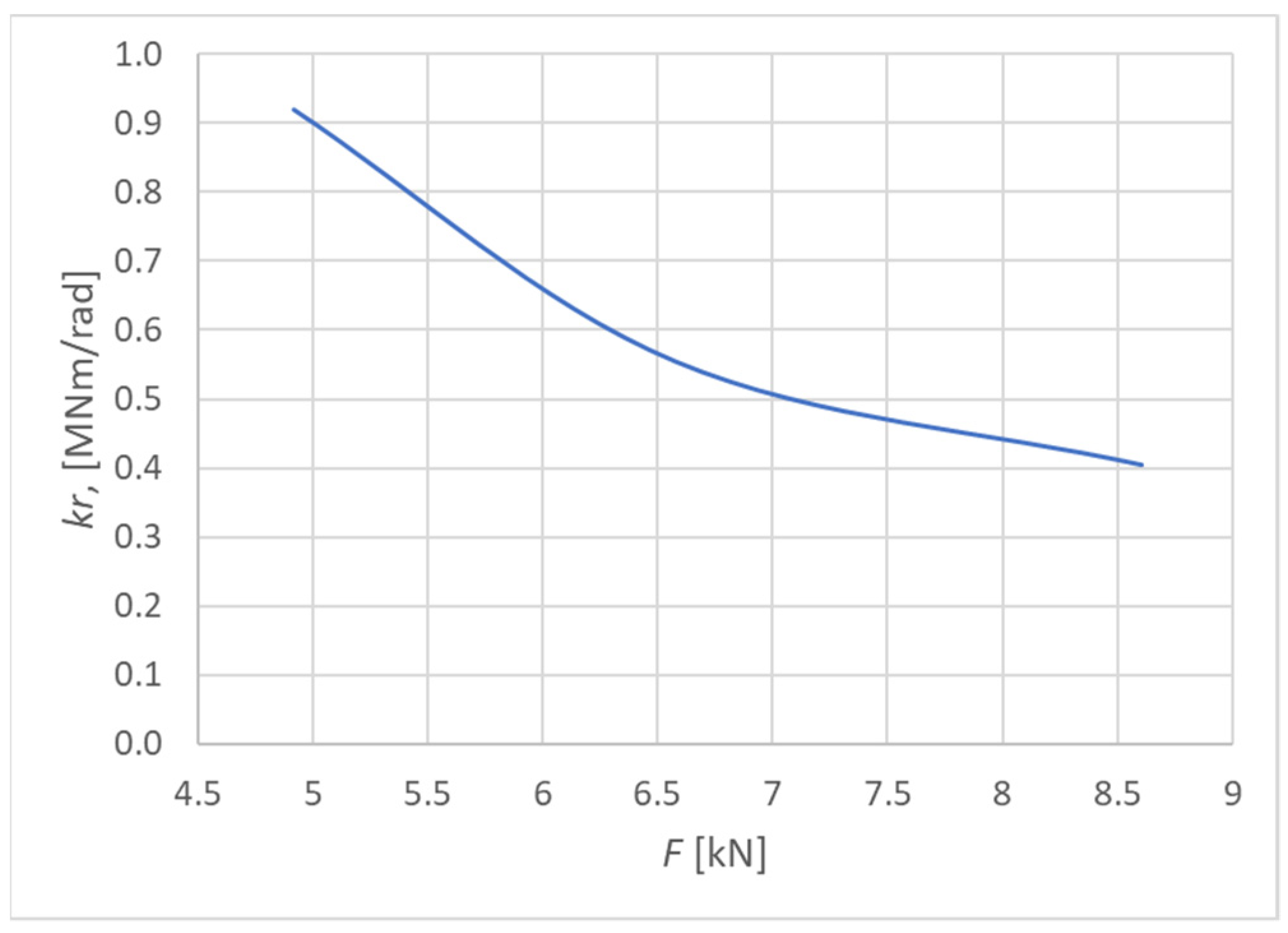
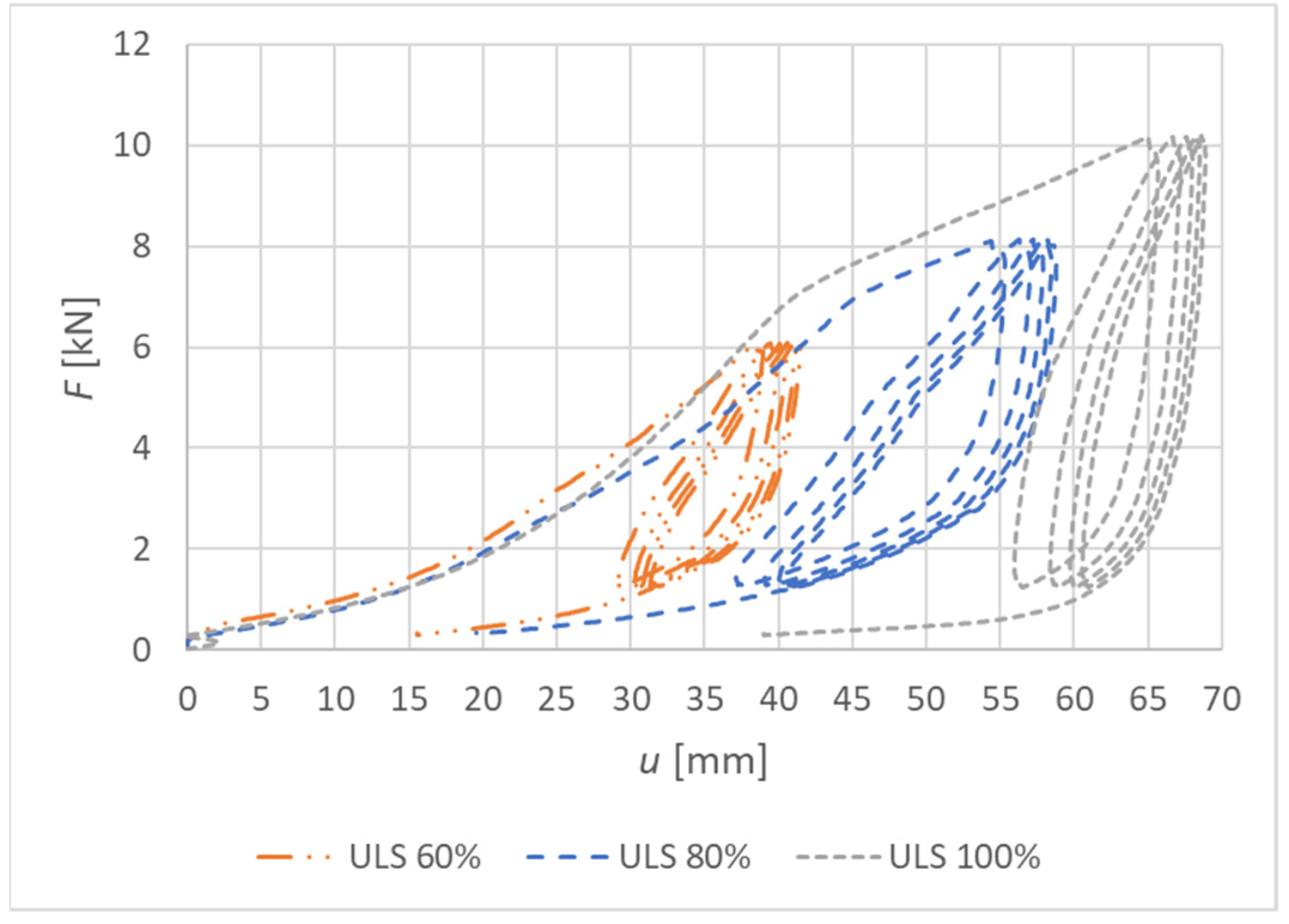
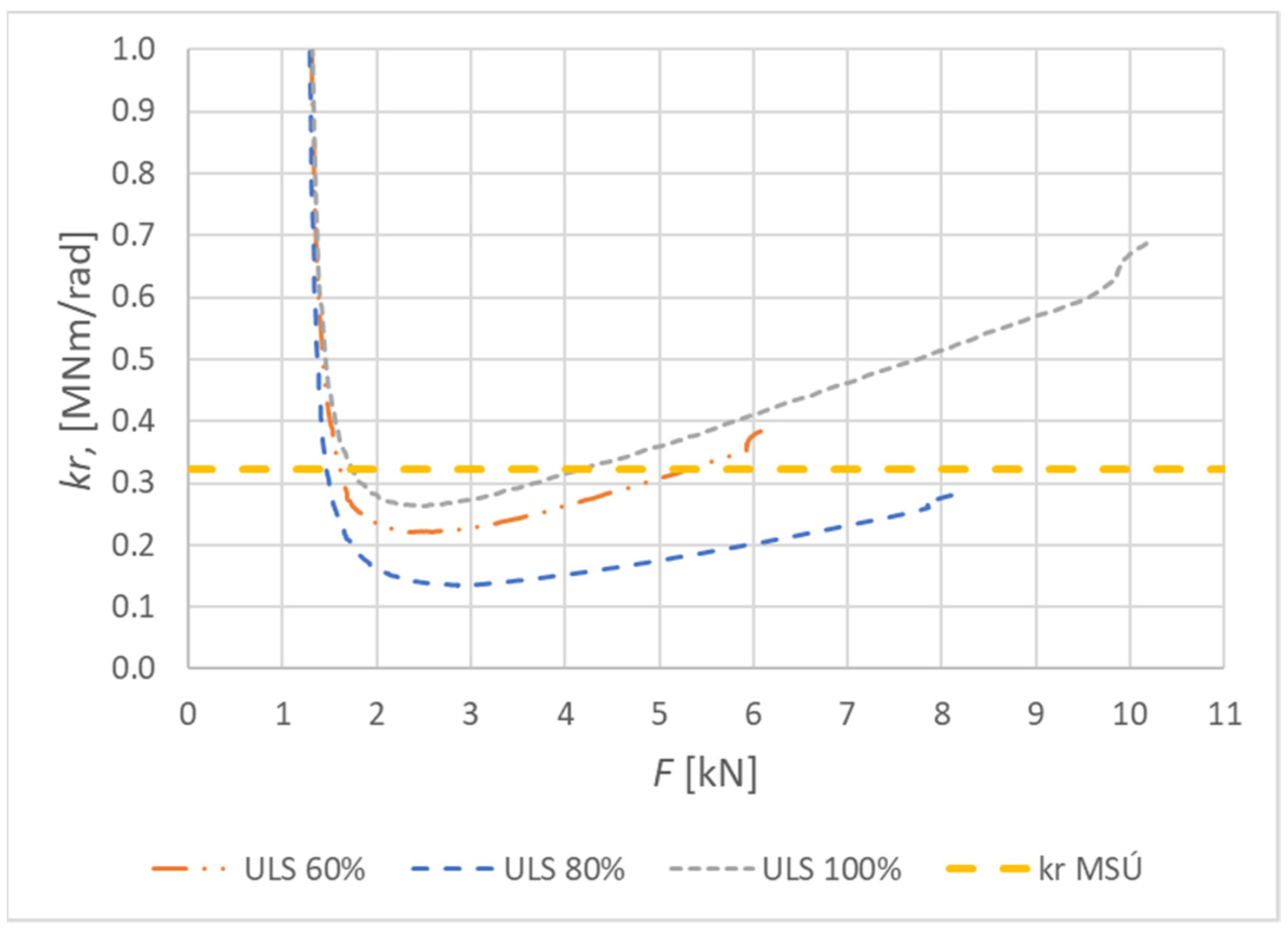
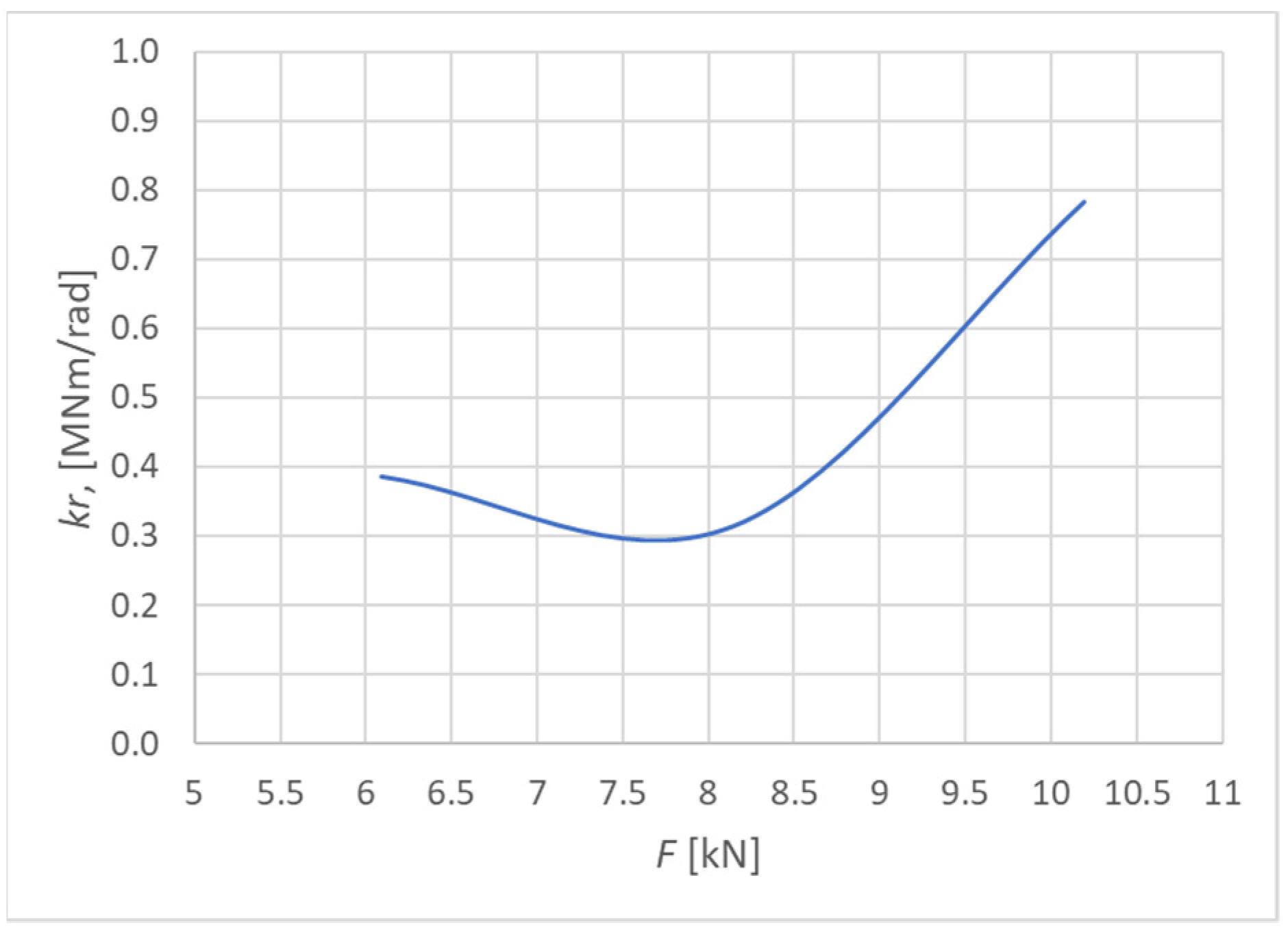
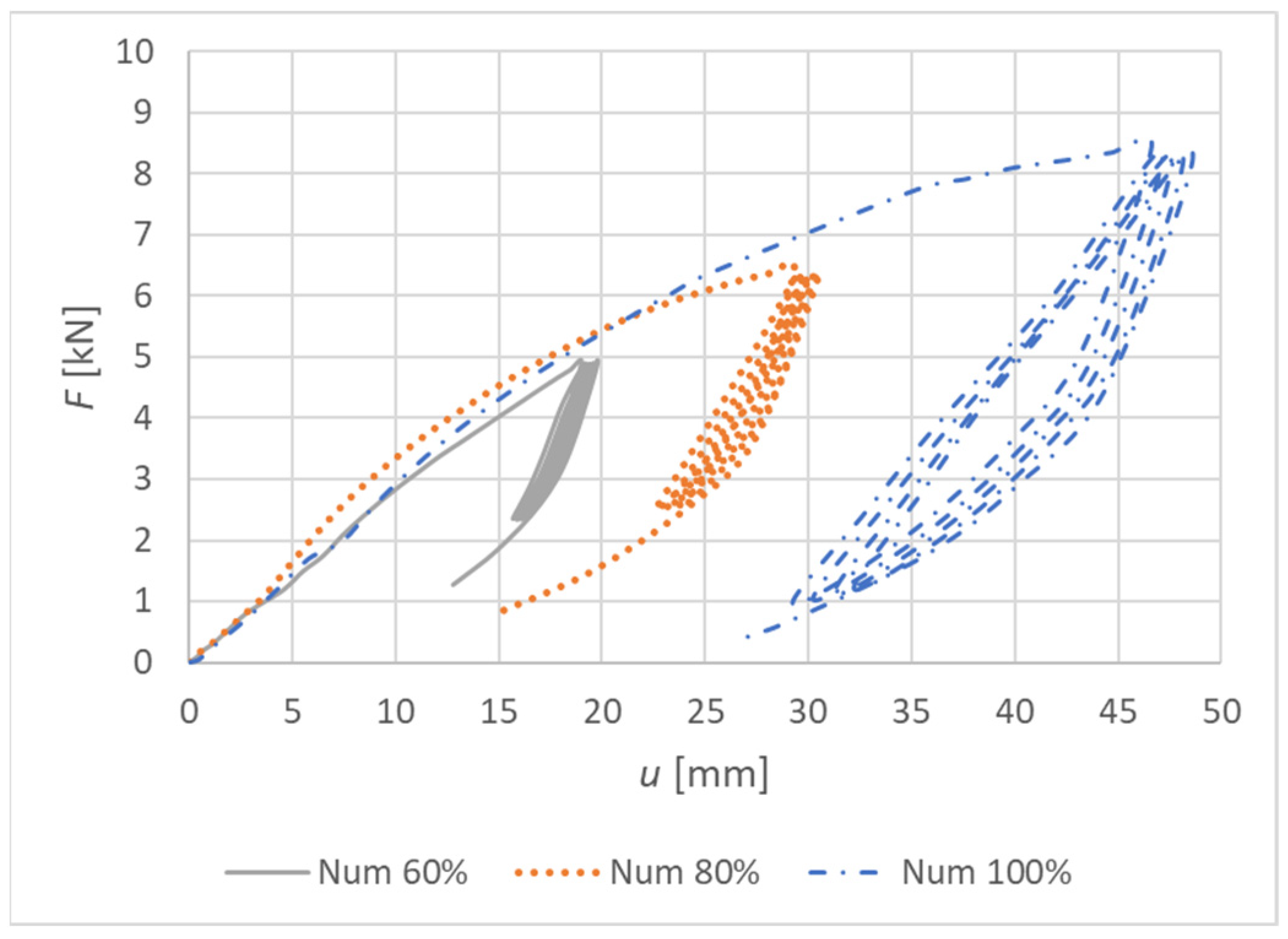
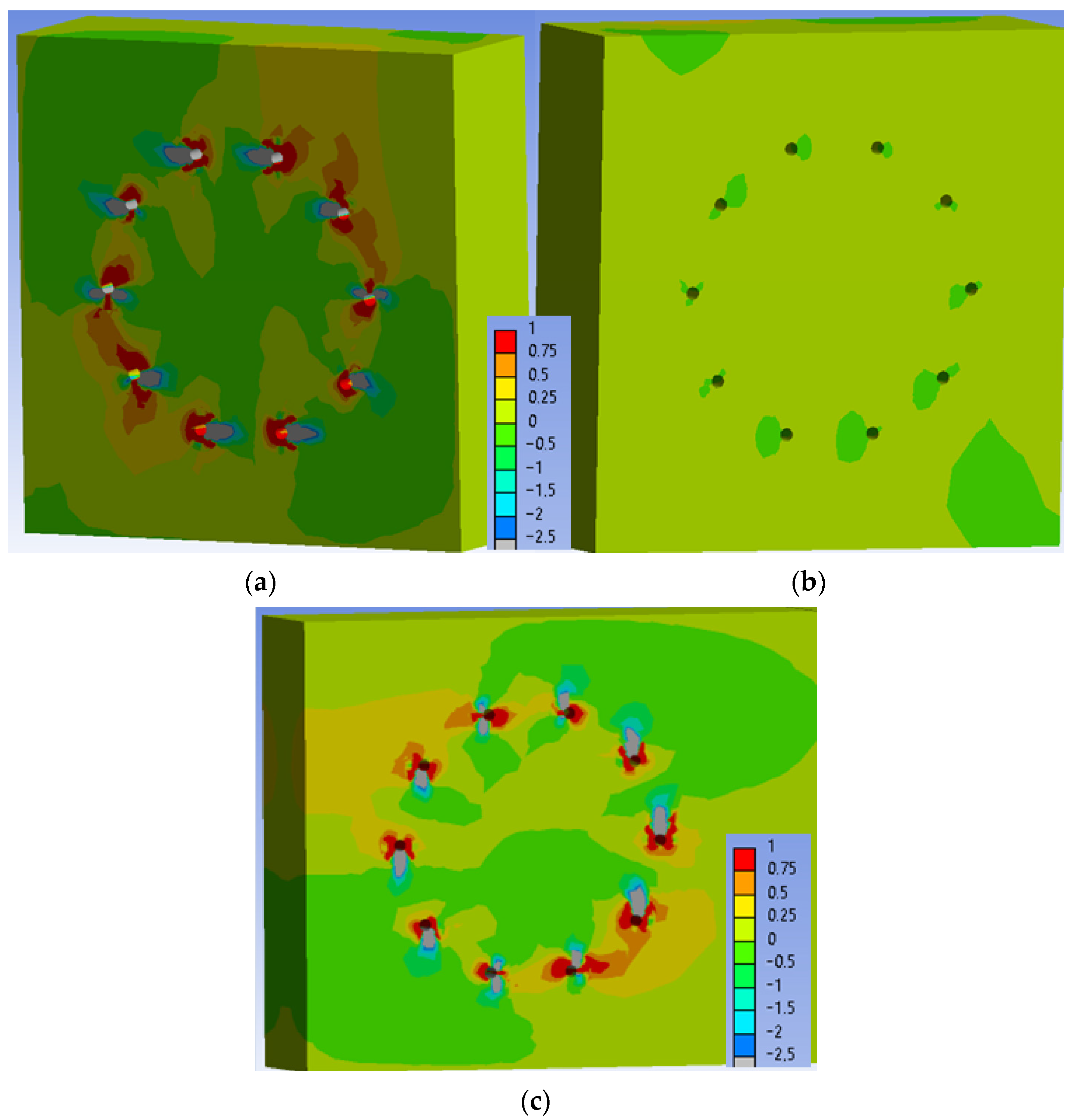

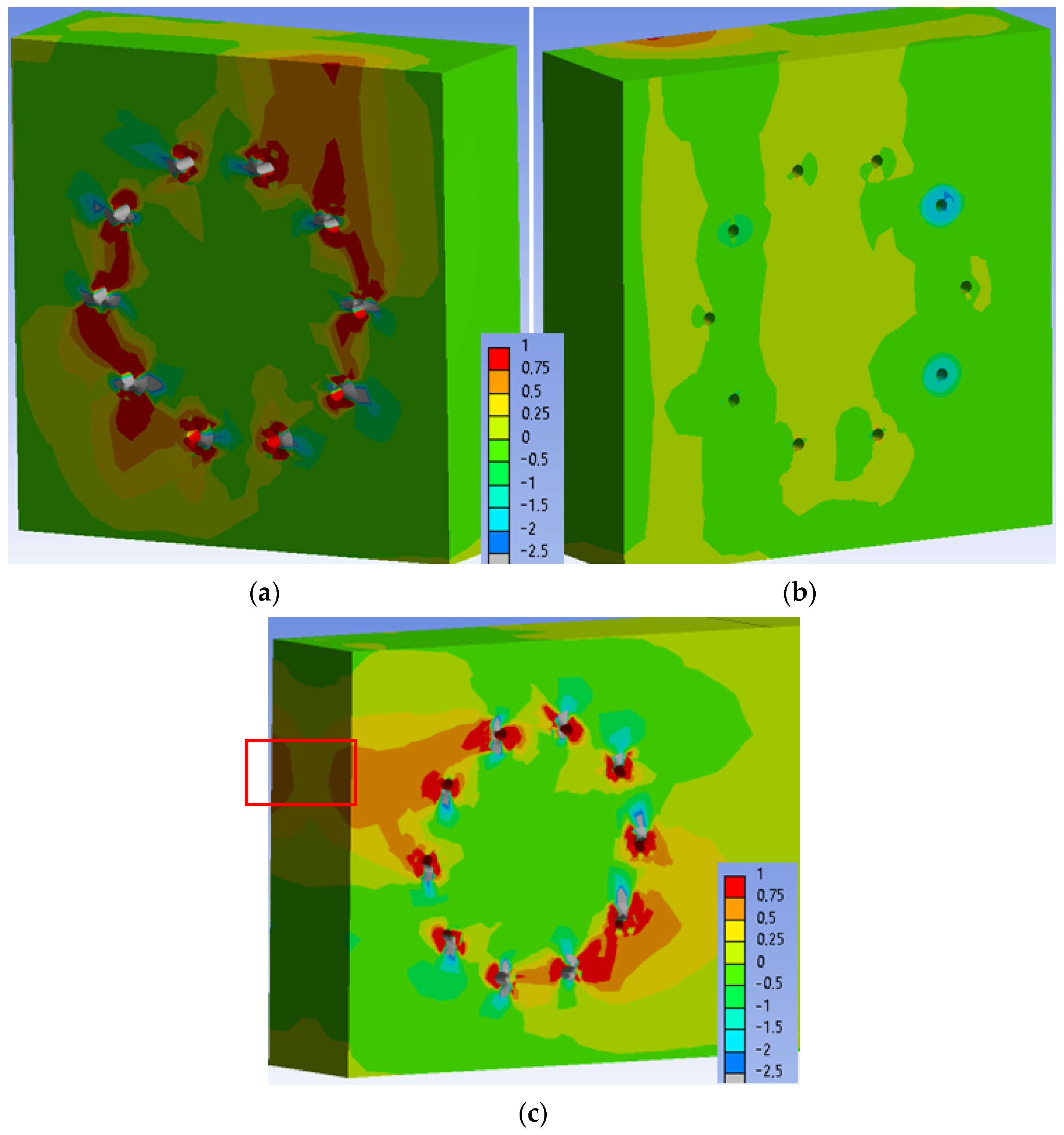
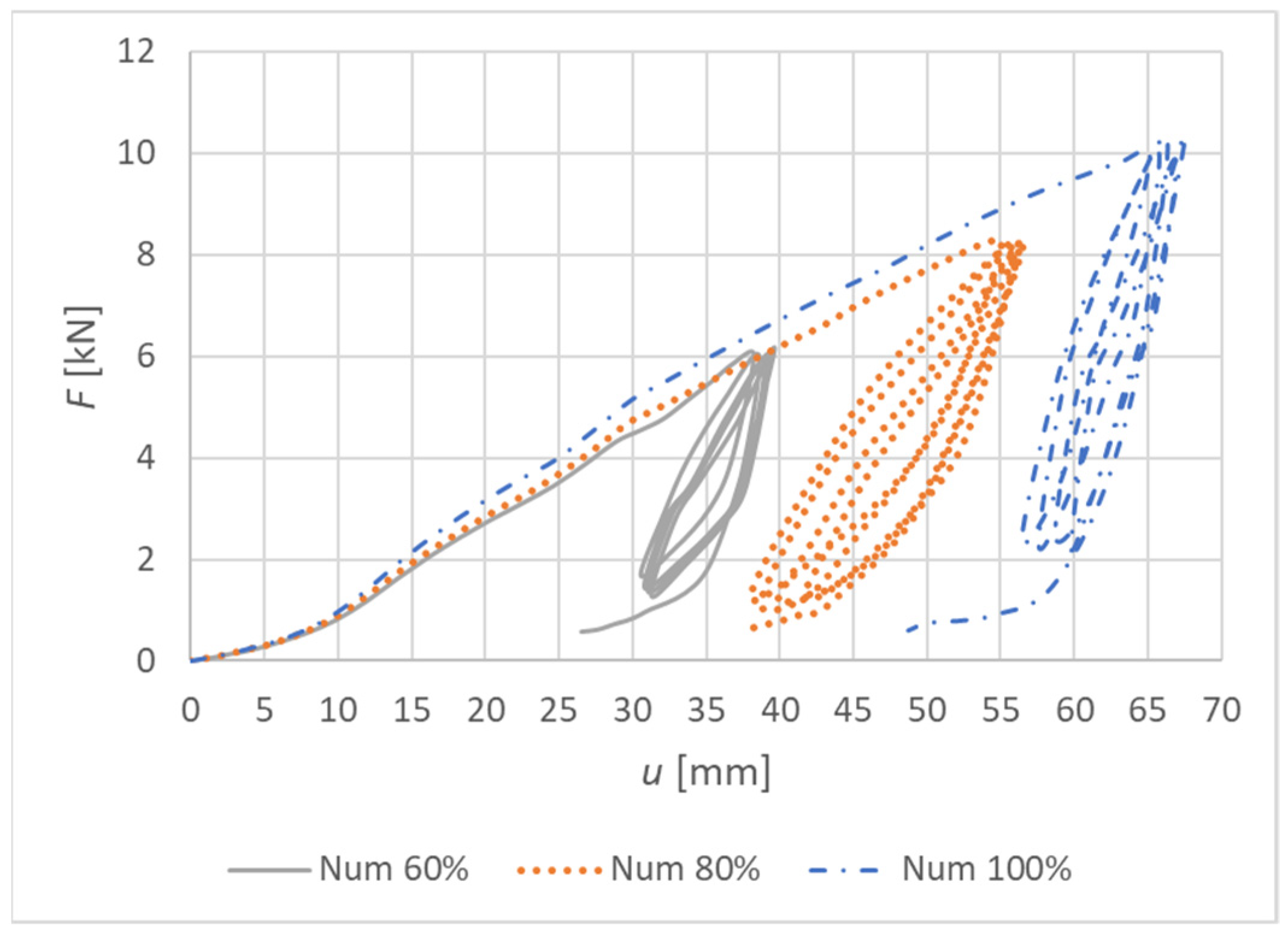

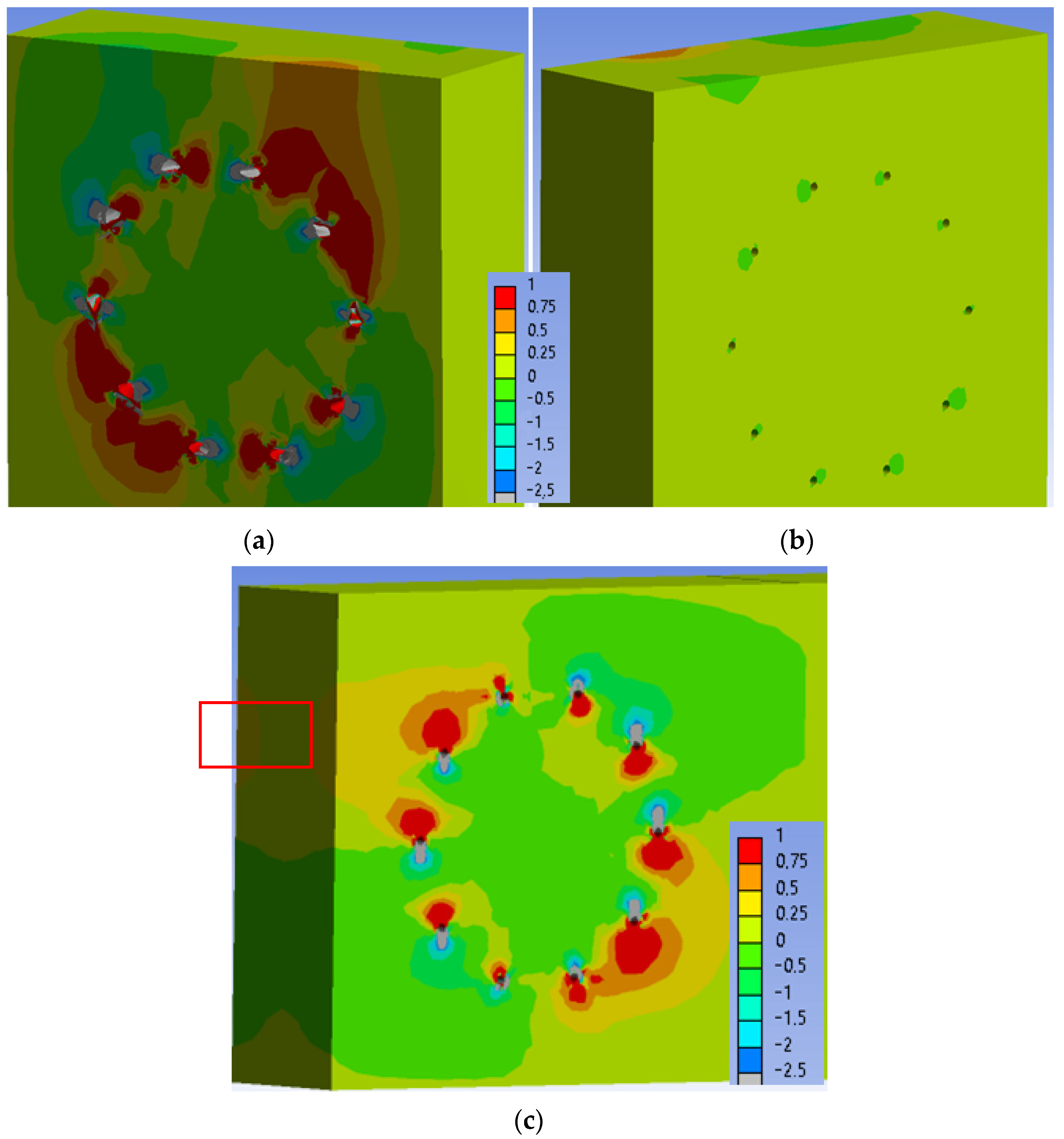

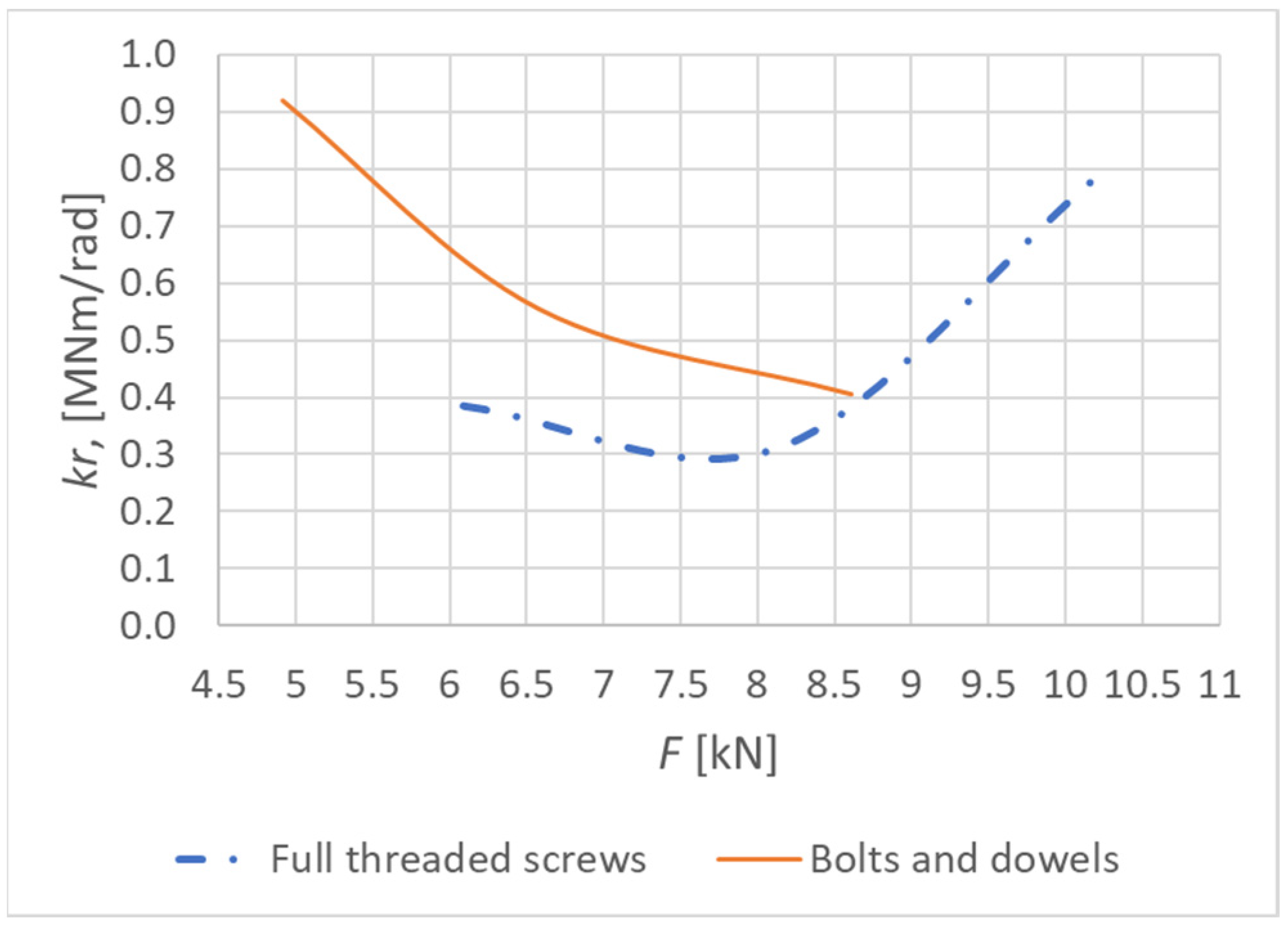
| Loading Step | Bolts and Dowels | Fully Threaded Screws | ||
|---|---|---|---|---|
| From | To | From | To | |
| (kN) | (kN) | (kN) | (kN) | |
| Step 1 | 0 | 4.93 | 0 | 6.31 |
| Step 2 | Hold | Hold | ||
| Step 3 | 4.93 | 0.85 | 6.31 | 1.05 |
| Step 4 | Hold | Hold | ||
| Step 5 | 0.85 | 4.93 | 1.05 | 6.31 |
| Step 6 | Hold | Hold | ||
| Repeating steps 3, 4, 5 four times. | ||||
| Timber Properties | Value | Unit |
|---|---|---|
| Young’s modulus in X | 9200 | MPa |
| Young’s modulus in Y | 740 | MPa |
| Young’s modulus in Z | 400 | MPa |
| Poisson’s ratio in XY | 0.47 | - |
| Poisson’s ratio in YZ | 0.25 | - |
| Poisson’s ratio in XZ | 0.37 | - |
| Shear modulus in XY | 650 | MPa |
| Shear modulus in YZ | 38 | MPa |
| Shear modulus in XZ | 700 | MPa |
| Steel Properties | Value | Unit |
|---|---|---|
| Young’s modulus | 190,000 | MPa |
| Poisson’s ratio | 0.30 | - |
| Hill Yield Criterion | Value | Unit |
|---|---|---|
| Yield strength in X | 32 | MPa |
| Yield strength in Y | 1 | MPa |
| Yield strength in Z | 1 | MPa |
| Yield strength in XY | 6 | MPa |
| Yield strength in YZ | 3 | MPa |
| Yield strength in XZ | 6 | MPa |
| Bolts and Dowels | ||
| Yield strength | 670 | MPa |
| Ultimate strength | 970 | MPa |
| Hardening modulus | 1000 | MPa |
| Fully Threaded Screws | ||
| Yield strength | 690 | MPa |
| Ultimate strength | 1075 | MPa |
| Hardening modulus | 1000 | MPa |
| Load Level | F60% ULS [kN] | M60% ULS [kNm] | u [mm] | kr, 60% ULS [MNm/rad] | SD,kr,60 [MNm/rad] | AVG,kr,60 [MNm/rad] | kr, u, EC5 [MNm/rad] | Test/u [-] |
|---|---|---|---|---|---|---|---|---|
| 60% ULS | 4.93 | 3.80 | 3.06 | 0.955 | 0.023 | 0.917 | 0.323 | 2.96 |
| 3.13 | 0.934 | 2.89 | ||||||
| 3.21 | 0.911 | 2.82 | ||||||
| 3.25 | 0.899 | 2.78 | ||||||
| 3.27 | 0.894 | 2.77 |
| Load Level | F80% ULS [kN] | M80% ULS [kNm] | u [mm] | kr, 80% ULS [MNm/rad] | SD,kr,80 [MNm/rad] | AVG,kr,80 [MNm/rad] | kr, u, EC5 [MNm/rad] | Test/u [-] |
|---|---|---|---|---|---|---|---|---|
| 80% ULS | 6.50 | 5.01 | 6.85 | 0.563 | 0.005 | 0.554 | 0.323 | 1.74 |
| 6.92 | 0.558 | 1.73 | ||||||
| 6.98 | 0.553 | 1.71 | ||||||
| 7.02 | 0.550 | 1.70 | ||||||
| 7.04 | 0.548 | 1.70 |
| Load Level | F100% ULS [kN] | M100% ULS [kNm] | u [mm] | kr, 100% ULS [MNm/rad] | SD,kr,100 [MNm/rad] | AVG,kr,100 [MNm/rad] | kr, u, EC5 [MNm/rad] | Test/u [-] |
|---|---|---|---|---|---|---|---|---|
| 100% ULS | 8.66 | 6.67 | 12.58 | 0.408 | 0.002 | 0.401 | 0.323 | 1.26 |
| 12.63 | 0.406 | 1.26 | ||||||
| 12.68 | 0.404 | 1.25 | ||||||
| 12.69 | 0.404 | 1.25 | ||||||
| 12.70 | 0.404 | 1.25 |
| Load Level | F60% ULS [kN] | M60% ULS [kNm] | u [mm] | kr, 60% ULS [MNm/rad] | SD,kr,60 [MNm/rad] | AVG,kr,60 [MNm/rad] | kr, u, EC5 [MNm/rad] | Test/u [-] |
|---|---|---|---|---|---|---|---|---|
| 60% ULS | 6.31 | 4,86 | 9.39 | 0.383 | 0.002 | 0.386 | 0.323 | 1.19 |
| 9.28 | 0.388 | 1.20 | ||||||
| 9.34 | 0.385 | 1.19 | ||||||
| 9.33 | 0.386 | 1.19 | ||||||
| 9.33 | 0.386 | 1.19 |
| Load Level | F80% ULS [kN] | M80% ULS [kNm] | u [mm] | kr, 80% ULS [MNm/rad] | SD,kr,80 [MNm/rad] | AVG,kr,80 [MNm/rad] | kr, u, EC5 [MNm/rad] | Test/u [-] |
|---|---|---|---|---|---|---|---|---|
| 80% ULS | 8.10 | 6.24 | 15.28 | 0.314 | 0.000 | 0.313 | 0.323 | 0.97 |
| 15.32 | 0.313 | 0.97 | ||||||
| 15.33 | 0.313 | 0.97 | ||||||
| 15.35 | 0.313 | 0.97 | ||||||
| 15.36 | 0.313 | 0.97 |
| Load Level | F100% ULS [kN] | M100% ULS [kNm] | u [mm] | kr, 100% ULS [MNm/rad] | SD,kr,100 [MNm/rad] | AVG,kr,100 [MNm/rad] | kr, u, EC5 [MNm/rad] | Test/u [-] |
|---|---|---|---|---|---|---|---|---|
| 100% ULS | 10.17 | 7.83 | 8.77 | 0.688 | 0.069 | 0.784 | 0.323 | 2.13 |
| 8.08 | 0.746 | 2.31 | ||||||
| 7.67 | 0.787 | 2.44 | ||||||
| 7.51 | 0.803 | 2.48 | ||||||
| 6.73 | 0.896 | 2.77 |
| Load Level | F60%,num [kN] | M60%, num [kNm] | u [mm] | kr, 60%, num [MNm/rad] | SD,kr,num,60 [MNm/rad] | AVG,kr,num,60 [MNm/rad] | kr, u, EC5 [MNm/rad] | Num/u [-] |
|---|---|---|---|---|---|---|---|---|
| 60% ULS | 4.93 | 3.80 | 3.32 | 0.880 | 0.010 | 0.887 | 0.323 | 2.72 |
| 3.32 | 0.880 | 2.72 | ||||||
| 3.32 | 0.880 | 2.72 | ||||||
| 3.25 | 0.889 | 2.75 | ||||||
| 3.23 | 0.905 | 2.80 |
| Load Level | F80%, num [kN] | M80%, num [kNm] | u [mm] | kr, 80%, num [MNm/rad] | SD,kr,num,80 [MNm/rad] | AVG,kr,num,80 [MNm/rad] | kr, u, EC5 [MNm/rad] | Num/u [-] |
|---|---|---|---|---|---|---|---|---|
| 80% ULS | 6.50 | 5.01 | 6.71 | 0.575 | 0.022 | 0.609 | 0.323 | 1.72 |
| 6.51 | 0.593 | 1.84 | ||||||
| 6.32 | 0.611 | 1.89 | ||||||
| 6.12 | 0.631 | 1.95 | ||||||
| 6.09 | 0.634 | 1.96 |
| Load Level | F100%, num [kN] | M100%, num [kNm] | u [mm] | kr, 100%, num [MNm/rad] | SD,kr,num,100 [MNm/rad] | AVG,kr,num,100 [MNm/rad] | kr, u, EC5 [MNm/rad] | Num/u [-] |
|---|---|---|---|---|---|---|---|---|
| 100% ULS | 8.66 | 6.67 | 14.67 | 0.350 | 0.013 | 0.370 | 0.323 | 1.08 |
| 14.25 | 0.360 | 1.11 | ||||||
| 13.84 | 0.371 | 1.15 | ||||||
| 13.43 | 0.382 | 1.18 | ||||||
| 13.32 | 0.385 | 1.19 |
| Load Level | F60%,num [kN] | M60%, num [kNm] | u [mm] | kr, 60%, num [MNm/rad] | SD,kr,num,60 [MNm/rad] | AVG,kr,num,60 [MNm/rad] | kr, u, EC5 [MNm/rad] | Num/u [-] |
|---|---|---|---|---|---|---|---|---|
| 60% ULS | 6.31 | 4.86 | 7.68 | 0.469 | 0.007 | 0.457 | 0.323 | 1.45 |
| 7.81 | 0.461 | 1.43 | ||||||
| 7.92 | 0.454 | 1.41 | ||||||
| 8.02 | 0.449 | 1.39 | ||||||
| 7.92 | 0.454 | 1.41 |
| Load Level | F80%, num [kN] | M80%, num [kNm] | u [mm] | kr, 80%, num [MNm/rad] | SD,kr,num,80 [MNm/rad] | AVG,kr,num,80 [MNm/rad] | kr, u, EC5 [MNm/rad] | Num/u [-] |
|---|---|---|---|---|---|---|---|---|
| 80% ULS | 6.31 | 6.24 | 17.09 | 0.281 | 0.024 | 0.304 | 0.323 | 0.87 |
| 17.53 | 0.274 | 0.85 | ||||||
| 15.92 | 0.302 | 0.93 | ||||||
| 14.59 | 0.329 | 1.02 | ||||||
| 14.39 | 0.334 | 1.03 |
| Load Level | F100%, num [kN] | M100%, num [kNm] | u [mm] | kr, 100%, num [MNm/rad] | SD,kr,num,100 [MNm/rad] | AVG,kr,num,100 [MNm/rad] | kr, u, EC5 [MNm/rad] | Num/u [-] |
|---|---|---|---|---|---|---|---|---|
| 100% ULS | 10.17 | 7.83 | 10.36 | 0.582 | 0.038 | 0.638 | 0.323 | 1.80 |
| 9.85 | 0.612 | 1.89 | ||||||
| 9.50 | 0.635 | 1.97 | ||||||
| 8.97 | 0.672 | 2.08 | ||||||
| 8.78 | 0.687 | 2.13 |
| Type of Fastener | Test | kr, test [MNm/rad] | kr, num [MNm/rad] | kr, EC5 [MNm/rad] | kr, RS [MNm/rad] | kr, RSD [MNm/rad] |
|---|---|---|---|---|---|---|
| Bolts and dowels | 60% ULS | 0.894 | 0.905 | 0.323 | 0.293 | 0.299 |
| 80% ULS | 0.548 | 0.634 | ||||
| 100% ULS | 0.404 | 0.385 | ||||
| Fully threaded screws | 60% ULS | 0.386 | 0.454 | 0.202 | 0.206 | |
| 80% ULS | 0.313 | 0.334 | ||||
| 100% ULS | 0.896 | 0.687 |
Publisher’s Note: MDPI stays neutral with regard to jurisdictional claims in published maps and institutional affiliations. |
© 2022 by the authors. Licensee MDPI, Basel, Switzerland. This article is an open access article distributed under the terms and conditions of the Creative Commons Attribution (CC BY) license (https://creativecommons.org/licenses/by/4.0/).
Share and Cite
Johanides, M.; Lokaj, A.; Dobes, P.; Mikolasek, D. Numerical and Experimental Analysis of the Rotational Stiffness of a Timber Semi-Rigid Dowel-Type Connection. Materials 2022, 15, 5622. https://doi.org/10.3390/ma15165622
Johanides M, Lokaj A, Dobes P, Mikolasek D. Numerical and Experimental Analysis of the Rotational Stiffness of a Timber Semi-Rigid Dowel-Type Connection. Materials. 2022; 15(16):5622. https://doi.org/10.3390/ma15165622
Chicago/Turabian StyleJohanides, Marek, Antonin Lokaj, Pavel Dobes, and David Mikolasek. 2022. "Numerical and Experimental Analysis of the Rotational Stiffness of a Timber Semi-Rigid Dowel-Type Connection" Materials 15, no. 16: 5622. https://doi.org/10.3390/ma15165622
APA StyleJohanides, M., Lokaj, A., Dobes, P., & Mikolasek, D. (2022). Numerical and Experimental Analysis of the Rotational Stiffness of a Timber Semi-Rigid Dowel-Type Connection. Materials, 15(16), 5622. https://doi.org/10.3390/ma15165622








